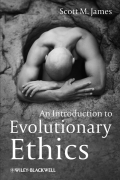
Offering the first general introductory text to this subject, the timely Introduction to Evolutionary Ethics reflects the most up-to-date research and current issues being debated in both psychology and philosophy. The book presents students to the areas of cognitive psychology, normative ethics, and metaethics INDICE: Introduction: A Philosopher and a Biologist Walk into a Bar . PartI: From Selfish Genes to Moral Beings: Moral Psychology after Darwin:. 1. Natural Selection and Human Nature. 1.1. The Basic Story. 1.2. Some Common Misunderstandings. 1.3. Mother Nature as Tinkerer. 1.4. Evolutionary Psychology and Human Nature. 1.5. An Evolved Mental Tool-Box. 1.6. Some (More) Common Misunderstandings. 1.7. Conclusion. 2. The (Earliest) Roots of Right. 2.1. Together We Stand?. 2.2. Inclusive Fitness and the Genes-Eye Point of View. 2.3. Love Thy Neighbor -- But Love Thy Family First. 2.4. False Positives and Core Systems. 2.5. A Quick Note on Altruism. 2.6. Reciprocal Altruism. 2.7. Conclusion. 3.The Cavemans Conscience: The Evolution of Human Morality. 3.1. What Makes Moral Creatures Moral. 3.2. The Evolution of Morality. 3.3. Explaining the Natureof Moral Judgments. 3.4. Conclusion. 4. Just Deserts. 4.1. The Ultimatum Game. 4.2. The Public Goods Game. 4.3. Winners Dont Punish. 4.4. The Benefits of Guilt. 4.5. A Lamb among Lions?. 4.6. An Explanation for All of Morality?. 4.7.Universal Morality or Universal Reason?. 4.8. Conclusion. 5. The Science of Virtue and Vice. 5.1. Distress Test. 5.2. Mind-Reading. 5.3. Thems the Rules. 5.4. Moral Innateness and the Linguistic Analogy. 5.5. Switchboards, Biases, and Affective Resonances. 5.6. Non-Nativist Doubts. 5.7. Conclusion. Part II: From What Is to What Ought To Be: Moral Philosophy after Darwin:. 6. Social Harmony: The Good, the Bad, and the Biologically Ugly. 6.1. From the Great Chain of Being, to the Tree of Life, to Morality. 6.2. Uprooting the Tree of Life. 7.Humes Law. 7.1. Deductively Valid Arguments. 7.2. You Cant Get Out What You Dont Put In. 7.3. Of the Last Consequence. 7.4. Blocking the Move from Might toRight. 7.5. Darwinism and Preserving the Human Species. 7.6. Conclusion. 8. Moores Naturalistic Fallacy. 8.1. The Open Question Test. 8.2. Failing the OpenQuestion Test: Desiring to Desire. 8.3. Failing the Open Question Test: Spencer. 8.4. Failing the Open Question Test: Wilson. 8.5. Conclusion. 9. Rethinking Moore and Hume. 9.1. Some Preliminary Doubts about the Open Question Test. 9.2. What Things Mean vs. What Things Are. 9.3. Implications for Social Darwinism. 9.4. Forays across the Is/Ought Gap: Searle. 9.5. Forays across the Is/Ought Gap: Rachels. 9.6. Conclusion. 10. Evolutionary Anti-Realism: Early Efforts. 10.1. This Is Your Brain on God. 10.2. Preliminaries. 10.3. Wilson. 10.4. The Argument from Idiosyncrasy. 10.5. The Argument from Redundancy. 10.6. Causation, Justification, and a Rotting Corpse. 10.7. Conclusion. 11. Contemporary Evolutionary Anti-Realism. 11.1. Napoleon Pills. 11.2. A Darwinian Dilemma. 11.3. Conclusion. 12. Options for the Evolutionary Realist. 12.1. Option 1: Learning Right from Wrong. 12.2. Option 2: Response Dependency. 12.3. Option 3: Virtue Ethics Naturalized. 12.4. Option 4: Moral Constructivism. 12.5. Objectionsto the Realist Options. 12.6. Conclusion. Notes. References. Index.
- ISBN: 978-1-4051-9397-9
- Editorial: Wiley-Blackwell
- Encuadernacion: Cartoné
- Páginas: 240
- Fecha Publicación: 03/12/2010
- Nº Volúmenes: 1
- Idioma: Inglés
